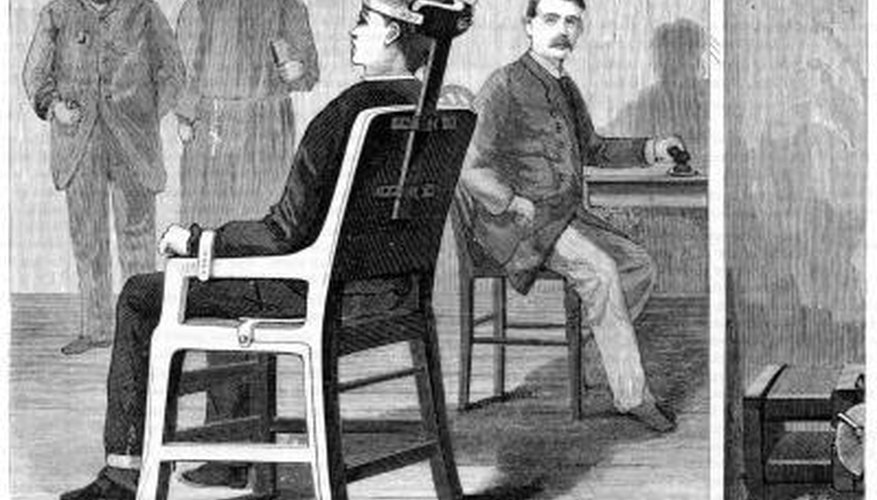Perpetrators of violent crimes in the 20th century could face any number of harsh punishments if they were caught and convicted. Although generally not as harsh as criminal punishments enacted in ancient times or in the middle ages, these methods of dealing with violent criminals were designed to deter others from committing similar offences.
Hanging
Hanging was used as a form of execution since the middle ages and continued as a form of capital punishment into the 20th century in the United States, Great Britain and other countries. Starting in the 18th century, prisoners stood on a trapdoor with a noose around their neck and dropped anywhere from 4 to 10 feet. A standard drop was designed to break a criminal's neck and produce instant paralysis followed by a quick death. In some cases, longer drops applied enough pressure to the neck to cause decapitation. As of 2011, only two states, Washington and New Hampshire, still offer hanging as an option to prisoners on death row.
- Hanging was used as a form of execution since the middle ages and continued as a form of capital punishment into the 20th century in the United States, Great Britain and other countries.
- In some cases, longer drops applied enough pressure to the neck to cause decapitation.
Electric Chair
Within a few years after Thomas Edison harnessed electricity to invent the light bulb, electrocution gained steam as a form of criminal punishment. Starting with Ohio in 1897, many states began adopting the electric chair as a method of capital punishment. The electric chair soon overtook hanging as a preferred method of execution and was frequently used throughout much of the 20th century. An electric chair delivered a dose of alternating current to a prisoner through electrodes placed on the body. Electricity was delivered in two jolts. The first caused brain death and the second caused organ failure. A few states continue to use the electric chair as a secondary method of execution, but most states that have the death penalty have phased it out in favour of lethal injection.
- Within a few years after Thomas Edison harnessed electricity to invent the light bulb, electrocution gained steam as a form of criminal punishment.
- Starting with Ohio in 1897, many states began adopting the electric chair as a method of capital punishment.
Gas Chamber
Gas chambers came into use as a form of capital punishment for criminals in the early years of the 20th century. In 1924, Nevada was the first state to execute a prisoner through the use of a gas chamber. Gas chambers work by pumping a toxic gas into a sealed chamber containing a prisoner until the gas asphyxiates him and causes death. Hydrogen cyanide is the gas most commonly used in a gas chamber. Other gases used include carbon monoxide and carbon dioxide. Reports of suffering before death led the gas chamber to fall out of use in favour of lethal injection by the latter years of the 20th century.
- Gas chambers came into use as a form of capital punishment for criminals in the early years of the 20th century.
- In 1924, Nevada was the first state to execute a prisoner through the use of a gas chamber.
Firing Squad
Use of firing squad as a form of criminal punishment goes back nearly 2,000 years. Accounts have been passed down of Roman soldiers and Viking marauders executing prisoners with a firing squad using bows and arrows. In the 20th century, firearms made use of a firing squad a practical form of capital punishment. A firing squad is made up of several law enforcement officers who discharge their weapons simultaneously. The prisoner is typically blindfolded or hooded, as well as restrained, and can either sit or stand during the execution. Only three executions have occurred by firing squad in the United States since 1976. All three were prisoners in Utah.
- Use of firing squad as a form of criminal punishment goes back nearly 2,000 years.
- Accounts have been passed down of Roman soldiers and Viking marauders executing prisoners with a firing squad using bows and arrows.
Lethal Injection
In the late 20th century, lethal injection gained popularity as a more humane form of punishment for criminals on death row. Lethal injection works by introducing a fatal dose of drugs into a person's bloodstream. During lethal injections, a prisoner is put to sleep after the drug is injected. Then his breathing stops, followed by his heart. A three-chemical combination of sodium thiopental, pancuronium bromide and potassium chloride are typically used. Lethal injection is now the most commonly used form of capital punishment used in the United States, as it is considered to be less painful than other older forms of execution. In 1982, Texas became the first state to use lethal injection to execute a prisoner.
- In the late 20th century, lethal injection gained popularity as a more humane form of punishment for criminals on death row.
